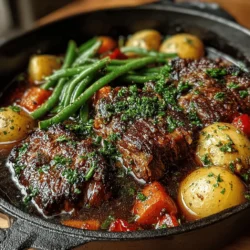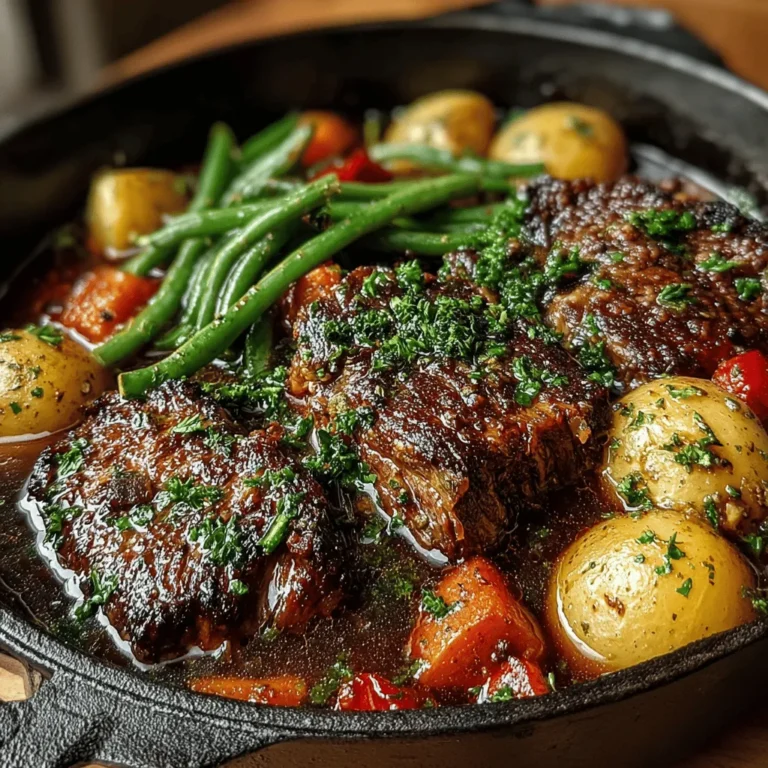Comforting Hearty Beef & Vegetable Pot Roast Recipe
When it comes to comfort food, few dishes evoke the warmth and satisfaction of a hearty beef and vegetable pot roast. This classic meal is not just food; it embodies the essence of home cooking, bringing families together around the dinner table. The rich aroma of slow-cooked beef mingling with fresh vegetables fills the kitchen, creating an inviting atmosphere that promises nourishment and joy. Whether it’s a chilly winter evening or a busy weeknight, a pot roast stands as a reminder of simpler times, making it a beloved staple in many households.
What makes a pot roast particularly appealing is its simplicity. With just a handful of ingredients and a bit of patience, you can create a dish that is both filling and flavorful. The beauty of this recipe lies in its versatility; it can easily be adapted to suit different dietary preferences and seasonal produce. Additionally, it’s an excellent way to utilize fresh ingredients, making it not only a delicious option but also a practical one for feeding a family. With hearty chunks of beef, vibrant vegetables, and aromatic herbs, a pot roast is the perfect centerpiece for a comforting family meal.
Understanding the Ingredients
Before diving into the recipe, let’s explore the primary ingredients that contribute to the dish’s rich flavor and texture. Understanding these components will not only enhance your cooking skills but also help you appreciate the nuances of this classic dish.
Beef Chuck Roast: The star of any pot roast is undoubtedly the beef, and for this recipe, the beef chuck roast is the best choice. This cut comes from the shoulder area of the cow and contains a good amount of marbling, which makes it ideal for slow cooking. The fat melts during the cooking process, ensuring the meat remains tender and juicy while also imparting a deep, beefy flavor to the dish. When selecting a chuck roast, look for a well-marbled cut, as this will enhance the overall taste and succulence of your pot roast.
Olive Oil: Olive oil plays a critical role in the cooking process, particularly during the initial searing of the beef. It not only helps create a flavorful crust on the meat but also adds its own rich, fruity notes to the dish. Using high-quality extra virgin olive oil can elevate the overall flavor profile, making your pot roast even more delightful.
Fresh Vegetables: A pot roast wouldn’t be complete without a variety of fresh vegetables. Traditional choices include carrots, potatoes, and green beans. Carrots add a natural sweetness and vibrant color, while potatoes provide a hearty, starchy element that absorbs the flavors of the broth. Green beans contribute a satisfying crunch and a pop of green that brightens the dish. Using fresh, seasonal vegetables not only enhances the taste but also boosts the nutritional value of the meal.
Herbs and Spices: The flavor of your pot roast is significantly influenced by the herbs and spices used. Thyme and rosemary are classic choices that lend an earthy aroma, while bay leaves add depth to the dish. Together, these herbs create a fragrant bouquet that complements the rich beef and sweet vegetables. A well-balanced seasoning of salt and pepper is essential to enhance the flavors of all the ingredients.
Red Wine: While optional, a splash of red wine can elevate your pot roast to new heights. The wine adds acidity, which helps to tenderize the meat, and its deep flavors meld beautifully with the broth. A full-bodied wine, such as a Cabernet Sauvignon or Merlot, is recommended for the best results. If you prefer not to use wine, you can substitute it with beef broth, which will still create a deliciously rich sauce.
Preparation Steps for a Perfect Pot Roast
Now that we have a solid understanding of the ingredients, let’s discuss the initial preparation steps that are crucial for achieving a perfect pot roast.
Importance of Seasoning: The first step in preparing your pot roast is to season the beef generously with salt and pepper. This simple act is paramount; it not only enhances the flavor of the meat but also forms the foundation for the entire dish. A good seasoning helps to create a flavorful crust during the searing process and ensures that the beef is well-flavored throughout.
Searing the Meat: Searing is a vital technique in pot roast preparation. It involves cooking the beef in hot olive oil until it develops a golden-brown crust. This Maillard reaction not only adds a rich flavor but also locks in the juices, keeping the meat tender during the long cooking process. To achieve the perfect sear, make sure your pot is preheated properly and avoid overcrowding the pan, which can lead to steaming instead of browning. Sear the beef on all sides, taking your time to develop that deep, caramelized crust.
Sautéing Aromatics: Once the beef is beautifully seared, it’s time to build the flavor base with aromatics. Remove the beef from the pot and set it aside. In the same pot, add chopped onions and minced garlic, sautéing them until they’re translucent and fragrant. The onions provide sweetness and depth, while garlic adds a pungent, savory note that permeates the dish. This step is essential for developing the complex flavors that make a pot roast truly special.
Deglazing the Pot: After the aromatics are sautéed, it’s time to deglaze the pot. This process involves adding a liquid—typically red wine or broth—to the hot pot to loosen the browned bits stuck to the bottom, known as fond. These bits are packed with flavor and will enhance the sauce that accompanies your pot roast. Use a wooden spoon to scrape up the fond while the liquid simmers, and allow it to reduce slightly before adding the rest of your ingredients. This step is crucial for building a rich, flavorful sauce that will coat the beef and vegetables as they cook.
As you progress through these initial preparations, the kitchen will start to fill with enticing aromas, setting the stage for the comforting meal that awaits. With the beef seasoned, seared, and complemented by fragrant vegetables and spices, you are well on your way to creating a comforting hearty beef and vegetable pot roast that will warm the hearts of your family and friends.
{{image_2}}
Mixing the Ingredients
When it comes to preparing a comforting beef and vegetable pot roast, the importance of mixing your ingredients cannot be overstated. Start by combining the tomato paste, beef broth, and your selection of herbs in a bowl. This mixture is crucial as it serves as the flavor foundation of your dish. Thoroughly blending these ingredients allows the tomato paste to dissolve completely, ensuring that every bite of your pot roast is infused with the rich, savory flavors derived from the herbs and the umami of the beef broth.
The herbs you choose can significantly impact the taste profile of the pot roast. Common choices include thyme, rosemary, and bay leaves. Make sure to mix them well with the liquid, creating a uniform sauce that will envelop the beef and vegetables as they cook. This combination of tomato paste and broth not only adds flavor but also contributes to the overall moisture, helping to keep the meat tender throughout the cooking process.
The Role of Liquid in Cooking
Liquid plays a pivotal role in the cooking process of a pot roast, particularly when it comes to creating a rich, comforting sauce. The blend of beef broth and red wine enhances the dish’s depth while also tenderizing the meat. As the pot roast simmers, the liquid reduces, concentrating the flavors and creating a luscious gravy that clings to the beef and vegetables.
Using a combination of broth and wine not only enriches the sauce but also balances the acidity with the sweetness of the vegetables, leading to a harmonious flavor profile. The moisture from the broth prevents the beef from drying out while it cooks low and slow, ensuring each bite is juicy and flavorful. This method of cooking allows the meat to absorb the flavors of the liquid, resulting in a pot roast that is truly comforting and satisfying.
Layering the Vegetables
The selection and preparation of vegetables are paramount for achieving the ideal texture and taste in your pot roast. Carrots, potatoes, and onions are classic choices, each providing a different flavor and texture. When layering your vegetables, consider cutting them into uniform sizes to ensure even cooking. Larger pieces will take longer to soften, while smaller pieces may cook too quickly and turn mushy.
When arranging the vegetables around the roast, place the denser vegetables like potatoes and carrots on the bottom, as they require more time to cook. Position the onions and any other quicker-cooking vegetables on top of the roast. This layering technique not only promotes even cooking but also allows the flavors to meld beautifully, as the juices from the beef seep down into the vegetables.
Cooking Techniques for Optimal Tenderness
The secret to a perfect pot roast lies in the technique of low and slow cooking. This method allows the tough fibers in the beef to break down gradually, transforming it into a tender and flavorful dish. Cooking your pot roast at a temperature of 300°F for 3 to 4 hours ensures that the meat becomes fork-tender while soaking up all the delicious flavors from the broth and vegetables.
Using a heavy-duty Dutch oven or a slow cooker can significantly enhance your results. These vessels retain heat well and distribute it evenly, creating a consistent cooking environment. Make sure to check the pot roast periodically; if you find that the liquid is reducing too quickly, feel free to add more broth to maintain moisture. The goal is to create a tender roast that can be easily shredded with a fork, while still being moist and flavorful.
Finishing Touches Before Serving
Once your pot roast has finished cooking, it’s essential to let the meat rest for at least 15 to 20 minutes before serving. Resting allows the juices to redistribute throughout the meat, ensuring it remains juicy and flavorful. If you slice into the roast too soon, the juices will escape, leaving you with a drier outcome.
As you prepare to serve, don’t forget to discard the bay leaf. While it adds depth to the flavor during cooking, it’s not meant to be eaten and can detract from the presentation of your dish. Removing it beforehand keeps your pot roast looking clean and appealing on the plate.
Serving Suggestions for Family Gatherings
When it comes to serving your hearty beef and vegetable pot roast, presentation matters. For an inviting meal, consider plating the roast and vegetables together on a large serving platter. Slicing the roast into thick pieces showcases the tender meat and allows your guests to admire the vibrant colors of the accompanying vegetables.
To enhance the meal, think about complementary side dishes or beverages that pair well with your pot roast. Creamy mashed potatoes or buttery egg noodles are classic accompaniments that soak up the delicious gravy. A fresh green salad with a light vinaigrette can provide a refreshing contrast to the rich flavors of the pot roast.
For beverages, consider serving a full-bodied red wine, such as a Cabernet Sauvignon or a Merlot, which complements the savory notes of the beef. Alternatively, a light, crisp ale can offer a pleasant balance to the meal.
Conclusion
In summary, this comforting hearty beef and vegetable pot roast is not only easy to prepare but also a delightful dish that brings families together. The combination of tender beef, flavorful vegetables, and a rich, savory sauce creates a meal that warms the heart and satisfies the appetite.
As you gather around the table with your loved ones, take a moment to appreciate the joy of cooking and sharing hearty meals. This pot roast is more than just food; it’s an experience that fosters connection and creates lasting memories. So, roll up your sleeves, gather your ingredients, and enjoy the process of making this comforting pot roast that will surely become a family favorite for years to come.


